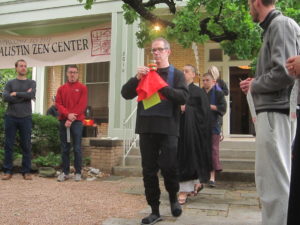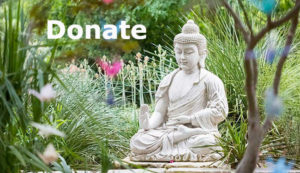- Friday April 22, 2022 at 6:00pm
Ceremonial Expression of Commitment to our Mother the Earth
 Join us in our celebration of the 52nd anniversary of
Join us in our celebration of the 52nd anniversary of
EARTH DAY!
All are invited to participate by offering words of gratitude, intention, and vow with regard to our commitment to our Mother the Earth on paper ‘ema,’ (plaques): in-person or online. Blank plaques will be available in the week approaching Earth Day. Please feel free to either submit an intention online below, or to stop by in-person (at the self-serve station at the base of the large post oak in the front yard of AZC) to write your wish or intention.
*** Please take this as an opportunity to purify body and mind before writing your intention, both physically and mentally. ***
On Friday April 22nd at 6:00pm we will hold our Earth Day ceremony in the front yard at AZC. Following a ritual purification of the space, we will offer bows, incense, and chanting of an excerpt from Dogen Zenji’s Mountains and Rivers Sutra – during which time the ema will be ceremonially hung from the great oak in the front yard. The oak tree, which was symbolically ordained in 2014, reminds us of our unfathomable and absolute mutual interconnection with all things, and specifically that our natural world greatly deserves and needs our utmost respect, care, and stewardship.
Interested in participating in pre-ceremony preparations?
- Help care for the space by raking the front gravel (rakes are on the corner of the Carriage House at the back of AZC).
- Join us after the morning program on Friday 4/22 to make a few Shide and Shimenawa for the ceremony.
- Download the Mountains & Waters chant to familiarize yourself with beforehand.
 Question: What is the significance of the rope tied around the large Post Oak tree and the zig-zag paper strips hanging from it?
Question: What is the significance of the rope tied around the large Post Oak tree and the zig-zag paper strips hanging from it?
Answer: The Austin Zen Center is a Soto Zen Buddhist temple with roots in Zen, which upon its arrival to Japan became heavily influenced and even interwoven with the dominant Japanese indigenous religion and culture of Shintoism: “the way of the kami.” Shinto is a system of prehistoric nature worship that imbued every mountain, every stream, and even rocks and trees with a spirit. These deities, known as kami, were considered cheerful and friendly to humans. If kept satisfied, they would watch over human affairs and refrain from causing natural disasters. Many Japanese people practice both Shintoism and Buddhism, and Shinto shrines are often found at Buddhist temples in Japan. The reverence and respect for nature is an integral part of our Zen practice, woven into our life of practice at a basic, almost primordial, level. On Earth Day we hail back to these ancient traditions of deep and sustaining respect, care, and stewardship of our planet Earth and the natural world, both as a manifestation of our Bodhisattva Vows and as acknowledgement of our mutual interconnectedness.
Shimenawa are lengths of laid rice straw or hemp rope used for ritual purification in Shinto. They are believed to act as a ward against evil spirits and are often set up at a ground-breaking ceremony before construction begins on a new building. They are found at Shinto shrines, torii gates, and sacred landmarks and can vary in diameter from a few centimetres to several metres, often festooned with rope tassels and zig-zag paper streamers called shide. A space bound by shimenawa indicates a sacred or pure space.
They are also used around yorishiro (objects capable of attracting spirits and being inhabited by them). Shimenawa ropes surround yorishiro to make their sacredness manifest. These notably include certain trees, in which case the inhabiting spirits are
called kodama, and cutting down these trees is thought to bring misfortune. In cases of stones, the stones are known as iwakura. Hanging white paper shide delineates a sacred space or object, and is an indication that spirits or gods are present.
 If you appreciate the teachings and activities offered at the Austin Zen Center, please consider making a donation or becoming a member today. We rely on the generous support of people like you to enable us to continue offering a full schedule of stillness and activity that helps all of us deepen our understanding of Zen practice and our own humanness.
If you appreciate the teachings and activities offered at the Austin Zen Center, please consider making a donation or becoming a member today. We rely on the generous support of people like you to enable us to continue offering a full schedule of stillness and activity that helps all of us deepen our understanding of Zen practice and our own humanness.
The Bells of Mindfulness
by Thich Nhat Hanh
Every one of us can do something to protect and care for our planet. We have to live in such a way that a future will be possible for our children and our grandchildren. our own life has to be our message.
The bells of mindfulness are sounding. All over the Earth, we are experiencing floods, drought, and massive wildfires. Sea ice is melting in the arctic, and hurricanes and heat waves are killing thousands. The forests are fast disappearing, the deserts are growing, species are becoming extinct every day, and yet we continue to consume, ignoring the ringing bells.
All of us know that our beautiful green planet is in danger. Our way of walking on the Earth has a great influence on animals and plants. Yet we act as if our daily lives have nothing to do with the condition of the world. We are like sleepwalkers, not knowing what we are doing or where we are heading. Whether we can wake up or not depends on whether we can walk mindfully on our Mother Earth. The future of all life, including our own, depends on our mindful steps. We have to hear the bells of mindfulness that are sounding all across our planet. We have to start learning how to live in such a way that a future will be possible for our children and our grandchildren.
I have sat with the Buddha for a long time and consulted him about the issue of global warming, and the teaching of the Buddha is very clear. If we continue to live as we have been living, consuming without a thought of the future, destroying our forests and emitting dangerous amounts of carbon dioxide, then devastating climate change is inevitable. Much of our ecosystem will be destroyed. Sea levels will rise and coastal cities will be inundated, forcing hundreds of millions of refugees from their homes, creating wars and outbreaks of infectious disease.
We need a kind of collective awakening. There are among us men and women who are awakened, but it’s not enough; most people are still sleeping. We have constructed a system we can’t control. It imposes itself on us, and we become its slaves and victims. For most of us who want to have a house, a car, a refrigerator, a television, and so on, we must sacrifice our time and our lives in exchange. We are constantly under the pressure of time. In former times, we could afford three hours to drink one cup of tea, enjoying the company of our friends in a serene and spiritual atmosphere. We could organize a party to celebrate the blossoming of one orchid in our garden. But today we can no longer afford these things. We say that time is money. We have created a society in which the rich become richer and the poor become poorer, and in which we are so caught up in our own immediate problems that we cannot afford to be aware of what is going on with the rest of the human family or our planet Earth. In my mind I see a group of chickens in a cage disputing over a few seeds of grain, unaware that in a few hours they will all be killed.
People in China, India, Vietnam, and other developing countries are still dreaming the “American dream,” as if that dream were the ultimate goal of mankind—everyone has to have a car, a bank account, a cell phone, a television set of their own. In twenty-five years the population of China will be 1.5 billion people, and if each of them wants to drive their own private car, China will need 99 million barrels of oil every day. But world production today is only 84 million barrels per day. So the American dream is not possible for the people of China, India, or Vietnam. The American dream is no longer possible even for the Americans. We can’t continue to live like this. it’s not a sustainable economy.
We have to have another dream: the dream of brotherhood and sisterhood, of loving-kindness and compassion. That dream is possible right here and now. We have the dharma, we have the means, and we have enough wisdom to be able to live this dream. Mindfulness is at the heart of awakening, of enlightenment. We practice breathing to be able to be here in the present moment so that we can recognize what is happening in us and around us. If what’s happening inside us is despair, we have to recognize that and act right away. We may not want to confront that mental formation, but it’s a reality, and we have to recognize it in order to transform it.
We don’t have to sink into despair about global warming; we can act. if we just sign a petition and forget about it, it won’t help much. Urgent action must be taken at the individual and collective levels. We all have a great desire to be able to live in peace and to have environmental sustainability. What most of us don’t yet have are concrete ways of making our commitment to sustainable living a reality in our daily lives. We haven’t organized ourselves. We can’t simply blame our governments and corporations for the chemicals that pollute our drinking water, for the violence in our neighborhoods, for the wars that destroy so many lives. It’s time for each of us to wake up and take action in our own lives.
We witness violence, corruption, and destruction all around us. We all know that the laws we have in place aren’t strong enough to control the superstition, cruelty, and abuses of power that we see daily. Only faith and determination can keep us from falling into deep despair. Buddhism is the strongest form of humanism we have. It can help us learn to live with responsibility, compassion, and loving-kindness. Every Buddhist practitioner should be a protector of the environment. We have the power to decide the destiny of our planet. If we awaken to our true situation, there will be a change in our collective consciousness. We have to do something to wake people up. We have to help the Buddha to wake up the people who are living in a dream.
